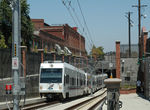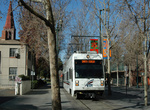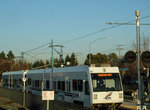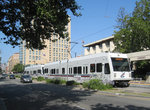San Jose, California
![]()
San Jose VTA Kinki-Sharyo LRV no. 917 leaving Convention Center Station inbound. Photo by Peter Ehrlich, October 2006.
Station By Station
Mountain View to Tasman
Starting in the northwest corner of the VTA system, the Mountain View-Tasman line begins at downtown Mountain View, next to the Caltrain station, and runs eastward, turning south to a station at Tasman. Caltrain operates commuter train service between San Francisco and San Jose with a few trains continuing south.
As the tracks leave Mountain View, they merge to a single track and continue to parallel the Caltrain tracks. The next station, Evelyn, is a single track station, whose only access is through a pedestrian tunnel under the Caltrain tracks. After Evelyn, the light rail tracks curve away from the Caltrain tracks, crossing the adjacent street. An interesting feature of this crossing, is that the northbound lanes have an additional crossing gate. This secondary gate comes down only a foot above the road and appears to be a physical barrier to stop errant automobiles. Once across the street, the line cuts through a new housing development and becomes double tracked, stopping at Whisman and Middlefield. The line then skirts the edge of Moffett Field (NASA/Ames), stopping at NASA/Bayshore and Moffett Park on its way to its way to Lockheed Martin.
As the line continues, it travels adjacent to several different streets as it snakes its way though new low-density office parks. Stops are made at Borregas, Crossman, and Fair Oaks.
Starting at Fair Oaks, the line runs in the median of Tasman Drive for the rest of the eastbound journey to Baypointe station. Additional stops are made at Vienna, Reamwood, Old Ironsides, Great America, Lick Mill, and Champion. The Great America station is located next to an amusement park of the same name, as well as the Santa Clara Convention Center. By the time the line gets to Champion, you know you are in Silicon Valley, where three of the four street corners at the station are occupied by Cisco Systems.
Tasman to Downtown and Santa Teresa
Trains to Santa Teresa turn south at First Street. The first stop on First Street is Tasman. As the line continues south down First Street toward downtown San Jose, the area becomes more urban and built up. Stops are made at River Oaks, Orchard, Bonaventura, Component, Karina, Metro/Airport and Gish. Most of these stations are offset side platforms, that is, northbound and southbound platforms are located on opposite sides of a cross street.
Just before the line gets to Civic Center station, there is a connection to a non-revenue track that links First Street trackage with the yard. Just south of the connection to the yard is Civic Center, followed by Japantown, which is the last stop before downtown.
As the line nears downtown, it ducks under a railroad spur, just before reaching the downtown transit mall. The tracks have to cross each other to accommodate running along one way streets, a block apart. The downtown transit mall is by far the nicest part of the system. For five blocks, the tracks run down a very wide granite sidewalk. There are trees planted along the middle of the sidewalk to offer some separation between light rail and pedestrians. The three stops in the transit mall are Saint James, Santa Clara and Paseo de San Antonio.
At the end of the transit mall, the tracks turn and head west, coming together again after crossing each other. The line heads west for several blocks, stopping in front of the Convention Center, before turning south again and stopping at the Children's Discovery Museum. The station is designed to look like part of the museum building, and is the most unique looking station on the system.
After leaving the station at the Children's Discovery Museum, the line makes an S curve, and ducks into the median of highway 87. The line stays in the median of the highway for the next five stops: Virginia, Tamien, Curtner, Capitol and Branham. If you want to get off at one of these stations, it is especially important to remember to request the stop as many of the stations are lightly used midday, and the train might otherwise pass through without stopping. At least the stations usually have security guards present. The station at Tamien is noteworthy as it also connects with Caltrain.
The line ducks out of the highway median just before coming to the next station, Ohlone/Chynoweth. The southbound platform of this station also serves the Almaden Shuttle (see below). South of Ohlone/Chynoweth, the main line ducks into the median of highway 85 as it leaves southbound to Santa Teresa. There are stops in the highway median at Blossom Hill, Snell and Cottle. The line then leaves the highway just before reaching the end of the line at Santa Teresa. The station at Santa Teresa is surrounded by a large park and ride lot that is currently only used to about a third of its capacity. Tail tracks extent past that station that store trains for rush hour.
Almaden Shuttle
Back at Ohlone/Chynoweth, the shuttle line is a single car train that runs to Almaden and back, stopping at an intermediate station in Oakridge. While a few people take the shuttle to the Oakridge Shopping Mall, Almaden does not see that many riders. Almaden has two tracks (the rest of the shuttle line is single track), but only one of them is ever used and there is not much around the station; it's a pretty lonely place.
Tasman East-Capitol Light Rail
Friday, May 18th, 2001, was the official opening date of an extension from Baypointe eastward to Milpitas, a 1.9 mile section of a project known as the Tasman East Light Rail. A further extension to Alum Rock opened June 24, 2004, and the two segments together are known as the Tasman East-Capitol line. Current service patterns have trains from Alum Rock running east through Baypointe, turning south at Tasman to Downtown and then via Ohlone-Chynoweth to Santa Teresa.
Baypointe station, which has three tracks and two island platforms, was the former terminal for various service patterns. It is now operated as a through station for trains to/from Alum Rock. Prior to June 24, 2004, when the Capitol Line opened, trains from Santa Teresa terminated here while trains to/from Mountain View continued on Tasman East to I-880/Milpitas.
Between Baypointe and Milpitas are two stations, located at Cisco Way and I-880/Milpitas. East of I880/Milpitas, the line runs elevated because of the need to cross two active Union Pacific railroad branches. Two stations, Great Mall/Main and Montague, are located along the elevated structure, VTA's first use of such an alignment. After Montague, the line descends to street level in the center of the Capitol Expressway, to stop at Cropley, with farside platforms in each direction, and Hostetter, an island platform. Hostetter briefly served as a terminal station (between March and June 2004). Following Hostetter are Berryessa, Penitencia Creek and McKee Stations, all farside side-platform stations. Finally, the line terminates at Alum Rock station, with a center platform. Two tail tracks southeast of the station store LRVs not needed for basic service but which are tacked on for the evening rush. A proposed station at Gay Avenue, between McKee and Alum Rock, may be built if funding becomes available.
Vasona Line
The newest addition to VTA's light rail system is the Vasona Line, which extends westward from W. San Carlos Street near the Children's Discovery Museum Station into the city of Campbell. Vasona was once part of the Southern Pacific Railroad's line to and over the Santa Cruz Mountains into Santa Cruz, but was cut back to the east side of the mountain range in the 1940s or so. Peninsular Railway electric interurbans operated on portions of the Vasona Line into Campbell until April 1, 1932.
This 5.3-mile, $317 million route begins at Museum (Vasona) Junction, where a half-grand union is located. The tracks pass under Route 87 Freeway, then immediately curve to the right (northward) along Delmas Street to San Fernando Street, and curve left to reach San Fernando station. From here, the tracks burrow under San Jose Caltrain Station (called Diridon), emerging on the west side of the station and track complex at San Jose Diridon station. Interchange of passengers between Vasona LRT and commuter trains of Caltrain, ACE (Altamont Commuter Express) and Amtrak takes place here.
Then the line curves southwestward, becomes single track, and joins up with the Union Pacific (ex-Southern Pacific) Vasona Branch, and UP freights and VTA light rail trains share the right-of-way, which will be the first real occurrence of simultaneous railroad and LRT operations (although the Moffett Field branch, basically disused, shares trackage with the Tasman West line through Mountain View). The trackway cuts a diagonal swath through west San Jose, stopping at Race, Fruitdale, Bascom, and Hamilton before basically paralleling Route 17 Freeway and into Downtown Campbell and Winchester. The line is single track between San Jose Diridon to just before Fruitdale, then double track through Bascom, and becomes single track as it crosses Hamilton on an elevated viaduct (easily the most spectacular feature and station on the branch) before becoming double track again just east of Downtown Campbell, remaining that way to Winchester. There is no actual physical track connection between Vasona LRT and Union Pacific. but a spur from the UP crosses the LRT rails just west of its southwesterly turn away from the railroad main line.
A 1.5-mile, 2-station extension, Phase 2, will be built when full funding comes through. When completed, two more stations at Hacienda and Vasona Junction in Los Gatos will be added to the route. A station at West San Carlos, between San Jose Diridon and Race, will also be built in the future.
The original intention was to begin service on this line on August 12, 2005, with service through-routed with the Tasman West route, doubling frequency on N. First Street and through downtown San Jose. However, the FRA stepped in literally at the last minute with issues regarding mixed operation of LRVs and freights on the line, forcing a postponement to October 1, 2005 while resolution of the issues was negotiated. In the meantime, service to San Fernando and San Jose Diridon Stations, which were not part of the FRA-controlled portion of the route, began on July 29 with an unusual operation using 3-car trains from the Santa Teresa Branch terminating at San Jose Diridon. This was to move crowds attending the first San Jose Grand Prix auto race, which had downtown blocked off, severing normal operations for three days. VTA then decided to open these two stations permanently on August 1 with the planned Tasman West/Vasona through-routed service. In normal practice, the connecting turnouts from Santa Teresa to Vasona will not be in use.
Route Map

Track Map

Photo Gallery
| Five Random Images | ||||
 Image 40797 (159k, 720x478) Photo by: Peter Ehrlich Location: Diridon Tunnel |  Image 43517 (174k, 720x478) Photo by: Peter Ehrlich Location: Japantown/Ayer |  Image 46741 (306k, 864x574) Photo by: Peter Ehrlich Location: Transit Mall-St John |  Image 59005 (180k, 864x645) Photo by: Peter Ehrlich Location: Mountain View |  Image 67482 (242k, 864x596) Photo by: Peter Ehrlich Location: Convention Center |
Photos By Location
Photo locations: Mountain View, Evelyn, Between Evelyn & Whisman, Whisman, Middlefield, NASA/Bayshore, Moffett Park, Lockheed Martin, Borregas, Crossman, Fair Oaks, Vienna, Between Vienna and Reamwood, Reamwood, Tasman/Birchwood (Between Reamwood and Old Ironsides), Old Ironsides, Great America, Lick Mill, Champion, Baypointe Line-Loc. Unknown, Baypointe, Cisco Way, I880-Milpitas, Great Mall, Montague, Capitol/Autumnvale, Cropley, Hostetter, Berryessa, Penitencia Creek, McKee, Gay Avenue, Alum Rock, Tasman East Line-Loc. Unknown, Tasman, Orchard, River Oaks, Bonaventura, Karina, Component, Metro/Airport, Gish, VTA Shops/Yard, N. 1st & Younger (Yard Leads), N. 1st & Hedding, N. 1st & Mission, N. 1st & Taylor, N. 1st & Jackson, Civic Center, Blossom Hill, Japantown/Ayer, N. 1st & Hensley, N. 1st & Bassett/S.P. Underpass, N. 1st & Julian, N. 1st & Devine, Transit Mall, Transit Mall-St. James, Transit Mall-St John, Transit Mall-Santa Clara, Transit Mall-San Fernando, Transit Mall-Paseo de San Antonio, Transit Mall - San Carlos, San Carlos/Market, Convention Center, San Carlos/Almaden e. of Vasona Jct., Vasona Jct., Children's Discovery Museum, Virginia, Tamien, Curtner, Capitol, Branham, Ohlone/Chynoweth, Snell, Cottle, Santa Teresa, Oakridge, Almaden, San Carlos w. of Vasona Jct./Guadalupe R., Along Delmas Street, San Fernando, Diridon Tunnel, San Jose Diridon, Park Avenue Overpass, Race, Fruitdale, Bascom, Hamilton, Downtown Campbell, Winchester
Links
Kelley Park Vintage Trolley. The San Jose Trolley & Railroad Corp. operates some vintage trolley cars in San Jose's Kelley Park.
Official Site - Santa Clara Valley Transportation Authority. The official site of the VTA, including schedules, fares, and more.
Page Credits
By Eric Haas and Peter Ehrlich. Maps by Michael Calcagno and Steve Hoskins.